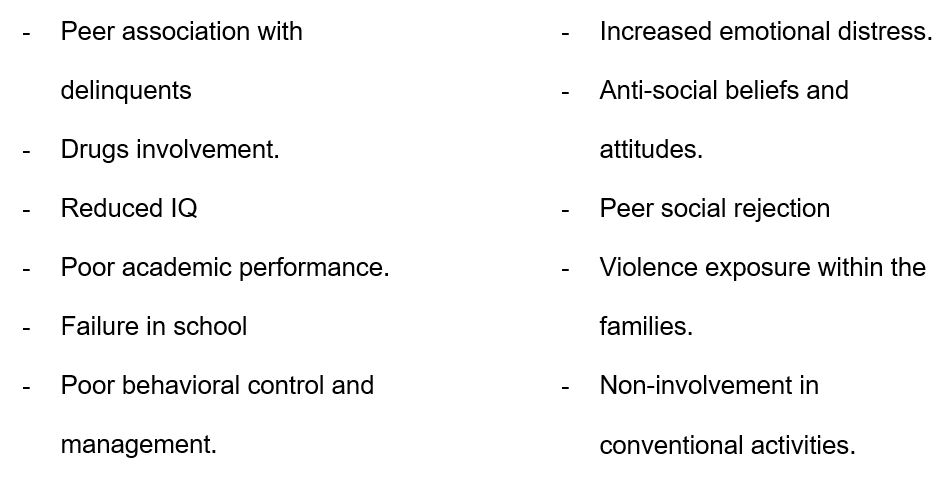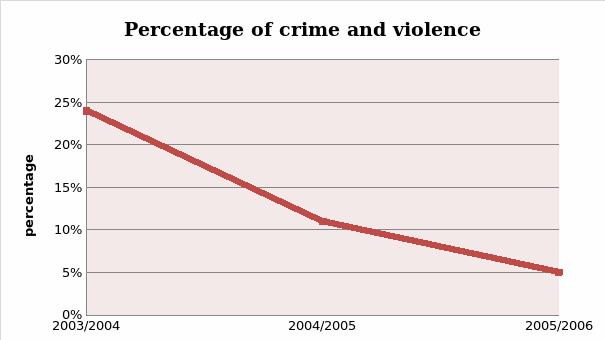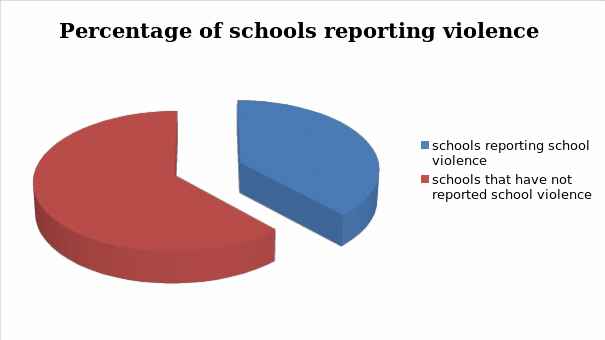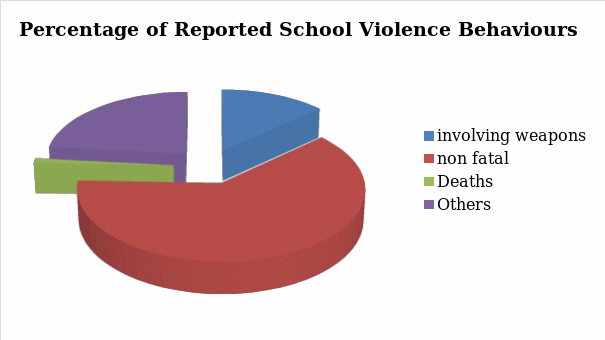- Introduction
- Risk factors associated with middle level school violence
- Statistical Evaluation of Juvenile Crime in American Schools
- Creation of a crisis management plan
- Response to violent incidents
- Establishing communication
- Working with media
- Aiding victim recovery
- Reporting incidents of violence
- Enforcing conduct code
- References
Introduction
Violence has persistently pervaded American schools. Such acts not only distort school operations, but have also had the effect of posing a threat to peace loving students and the school fraternity in general (Crews et al, 2007, p11). Juvenile crime acts have often been associated to various causative factors. The roots of such violent behaviors by juvenile are traceable to a pile load of social ills. These include weapons prevalence, contact wit gangs, prejudice, drugs, media influence and general moral decadence. For instance, in the Jonesboro incidence 1998, Michael Johnson and Andrew Golden aged 13 and 11 respectively, pulled a fire alarm to lure students and staff outside the building and fired at the from the woods leading to the death of four students and one teacher with up to other 10 seriously wounded (Crews et al, 2007, p11). While schools took punitive measures against student violence, such a case was too tragic for the school to handle and signaling a new era in juvenile violence.
Risk factors associated with middle level school violence
Recent researches have tried to establish the key factors that may motivate violence amongst middle level students within America. While individual factors have often been cited as not constituting violent behaviors amongst children, they in one way or the other increased a student vulnerability to such behavior. Such factors include: violent victimization history, attention deficits/learning disorders, and early aggressive behavior history (Jackson, 2006, p 632). However most of the violent behaviors are attributed to external factors which include the under listed:

Relational factors are also believed to being capable of leading the children into violent behaviors within the school. Such include the under listed:
- Inconsiderate, harsh or even lax disciplinary measures.
- Lack of parental involvement and commitment.
- Increased emotional attachment to parents.
- Illiteracy on the side of parents and low income.
- Substance abuse by parents or criminal parents.
- Poor communication channels within the family.
- Lack of adequate monitoring and children supervision.
Other researchers have suggested that the community also posed its set of risks to the children’s future and current behavior. Such include diminished opportunities economically; poor resident’s concentration, increased levels of transiency, increased family disruption levels, reduced community participation and living in socially disorganized environs. See model diagram below:

Across the 1990’s, rates of juvenile crime and more particularly school violence tremendously increased sparking both national outcry and concern. A 2008 National Report on Juvenile Offenders and Victims indicated that juvenile arrest rose from 1998 to 2005 stagnating at around 650 arrests per 100,000 juveniles within 10-17 age bracket (OJJDP, 2008, p29). This figure represented an alarming increase on the number of juvenile related crimes. Kelley, in his article noted that between 1986 and 1995, juvenile crimes rose by a shocking 67% and was consistently on an upward trend (Kelley et al. 1997, p46). The 2008 national report of juvenile crimes also revealed that with juvenile victimization, an accompanying rise in juvenile crime as recorded and vice versa is true (OJJDP, 2008, p 30). In essence this revealed the need for encouraging transformational leadership rather than a punitive approach towards fighting juvenile violence (OJJDP, 2008, p 31). Perhaps the most shocking part was the revelation that school violence accounted for up to 57% of the juvenile related crimes in 1999 and only to shoot to 62% by 2006(OJJDP, 2008, p 37). The national report further highlighted that around 18% of middle level students admitted to having carried a gun to school and shockingly statistics revealed that up to 12% of the aforementioned admitted to having considered using the gun for retaliatory attacks (OJJDP, 2008, p 39).
These troubling statistics and the consistent media coverage of violent incidence with schools e.g. the Littleton and Jonesboro incidences elevated school violence to the status of a national epidemic. National policy makers thus embarked on formulation of frameworks and policies aimed at curbing the same (Astor et al. 1997, p267). This called for all stakeholders including the parents, teachers, administrators, and enforcement agencies coming together in combating the menace. The arising movement aimed at securing schools in America involved development of a combination of preventive strategies, including surveillance camera installation, use of metal detectors (Lambert & McGinty 2002), development of long term prevention strategies such as mentoring, lessons on conflict resolution mechanisms (Lambert & McGinty 2002), and finally was the use of law enforcement agencies within the schools (Johnson, 2002, p109). The latter reaction often viewed as a reaction to violence in schools involved assigning of officers to schools and was referred to as the School Resource Office Program (COPS 2003).
The goal of the program was to ensure safety concerns were addressed in tandem with the provision of quality life to students through officer’s integration within the school environment (Leiber, Nalla, & Farnworth, 2006, p 142). However, the roles surpassed mere security provision as the officers were adequately equipped to act as counselors as a measure of preventing crimes from occurring rather than focus on reactionary strategies (COPS Office 2003). Previous researches have however come up with divergent opinions regarding the programs success. Most people have applauded the program though often accompanied by a raft of recommendations. This highlights the need for its modification and adjustment to adopt more transformational leadership strategies.
Violence prevalence in middle level schools in the American Schools.
A 2007 research by the department of education revealed that middle level school violence within the America has undergone tremendous decline since 2003 (see diagram below).

School violence in the America is considered a subset of youth violence across the district. Basically, it entails harmful behaviors considered unaccepted within the society. Such behaviors range from bullying, punching, slapping and use of weapons. All these combined form the statistical base of school violence within the county. Often victims suffer serious injuries and even some significant social and emotional damage. In rare circumstances such events results into deaths. Introduction of the SRO program affects the statistical data regarding the same and thus acts as measures of the success or failure of the program in the region.
School violence is a subset of youth violence. Statistics relating to rate of school violence in the county are maintained at the District County Office, the U.S department of Justice and the U.S Department of Education. These departments gather data, analyze it and maintain for future decision making and a deeper understanding of school violence. Additionally, it is important to note that these departments offer vital information for future planning.
Statistics reveal that 38% of public schools have reported an incidence of violence during the year 2005-2006 (Department of Education, 2008).

In a 2007 research it was cited that approximately 23% of students reported presence of gangs within their schools (Department of Education, 2008, p 23). In 2003-2004, 105 of the teachers within the schools faced injury threats from students (Department of Education, 2008, p 45). Additionally, statistics from the national education office reported several risky behaviors. The county’s survey classified the risky behaviors as follows: 5.9% of students reportedly carried weapons to school (e.g. knives, clubs or even guns), 7.8% of students threatened injury on the other or actually injured the other within the year while 12.4% of the students engaged in physical fights within the school premises. 22.3% of the students reportedly sold or offered illegal drugs to others within the school compound (CDCP, 2008, p 67).
Non-fatal victimization has also been frequently reported within the county. In 2006 for instance statistics revealed that up to 29 violent crime behaviors were recorded amongst a group of 1000 students (Department of Education, 2008, p 65). 2007 recorded a higher number of bullying behaviors from the middle level schools with the figure put at 32% with 4% of the students facing cyber bullying (Department of Education, 2008, p 66). Such bullying children engaged in activities like fights, property vandalism, skipping of school while others dropped out.
Another form of violence that has been recorded within the county involved cases of violent deaths. Though at a small figure such school deaths accounted for less than 1% of cases of homicide and suicide amongst the children aged 5-18 years old (Department of Education, 2008, p 44). In 2001- 2008, 38 separate incidences of students deaths were recorded contributing to the Nationwide’s 16.5 % student homicides (Department of Education, 2008, p 45). Middle school associated student homicides registered a significant drop between the years 1992 and 2006 unlike in the recent years where they have remained significantly stable with little reduction (Department of Education, 2008, p 56). This has raised the question as to whether or not the SRO program is running out of ideas against the ever growing student reasoning. School associated deaths are reportedly takes place during the transition hours such break times and over lunch with a higher likelihood of occurrence at the beginning of the term. Researches have indicated that nearly 50% of the perpetrators of such acts issued some form of warning ranging from threat issuance to leaving of notes prior to their actions (National School Safety and Security Services, 2007, p 67).

Such deaths accounted for a little percentage as compared to the number of students who sought medical care for non-violent related injuries acquired during school. If these statistics are to by then probably the information recorded bodies still have a long way to get the actual violence related statistics. While some forms of injuries are considered minor for instance cuts, bruises and broken bones, some are life threatening and could even result into permanent disabilities for instance gun shot wounds and head trauma. It is also important to acknowledge that not all forms of injury are visible. They come in a wide array of negative health outcomes such as depression, anxiety and other forms of psychologically detrimental outcomes. A nationwide survey conducted in 2007 revealed that 5.5% of middle level school students missed schools at least once a month for fear of their safety (DCJS Crime Prevention Center, 2007, p 10). Such reasons for missing schools constantly increased between 1993 and 2005 but have not had any significant changes in the recent past (DCJS Crime Prevention Center, 2007, p 10). Also worth mentioning is the fact that up to 160,000 students nationally, leave school early for fear of being bullied by the others (DCJS Crime Prevention Center, 2007, p 12).
Statistical Evaluation of Juvenile Crime in American Schools
This paper investigates the impact of various factors on school violence in America.
Students violence relation to three family backgrounds (N=139)
Various factors contribution to school violence in America (N=139)
From the evaluations above, the leading causes of violence in schools are peer influence and drug abuse. The table below evaluates the relation between the two.
Comparison of peer influence and drug abuse (N=39)
Sampled violence frequency per individual students (N=139)
Relating family income background to juvenile crime incidence in American schools (N=66)
Strategies employed by the SRO program in fighting middle level school violence in the America.
Effectiveness of SRO program’s success is often attributed to the strategies that the relevant coordination district offices employ in tackling the of school violence. This section undertakes a stepwise description of the steps that the county employs in tackling school violence.
Creation of a crisis management plan
What is the level of the schools preparedness and ease of response towards school violence incidents? This is the primary question that the SRO strategic plan in the region sought to answer. The region’s schools defined violence as ranging from students fights to such major incidents like slaying through armed intrusion. The program took consideration of all the possibility including the latter whose occurrence is rare and bears little possibility of occurring. This was meant to ensure that acts like the one in Jonesboro are never allowed to recur again.
While the district administrators provided schools with general guidelines and procedure suggestions, each school was independently expected to customize the response measures to suit its conditions. The customized plans were thus developed with various stakeholders involved including teachers, administrators, counselors, and security personnel among others. Under these plans most schools were expected to assign the following functions to the SRO’s within the respective schools;
- Constant communication with the district office.
- Accompanying of injured students to the hospital in case of violence.
- Maintenance of order and peace within the school environment.
- Coordination of communication amongst various stakeholders.
- Notifying of parents and the relevant authorities of such incidence when they occur as appropriate.
However, the schools had the liberty of exploring the entire possible crisis and suggest additional roes to the SRO’s as may be deemed appropriate.
Response to violent incidents
Response to violent incidents is a key component of SRO strategic plan. Notable though is the fact that not all incidents are equally treated. This thus entails a guideline pertaining to a violent incident. The guidelines are as listed below;
- The SRO is expected to access the situation and determine the level of seriousness. Based on this assessment, the SRO identifies the relevant areas of school crisis management plan tat are applicable.
- Depending on the incident in question, the incident may either be handled within the school or the relevant authorities called in to help defuse the situation. Such measures may involve calling in the police.
- The SRO‘s are also expected to call for medical assistance in such circumstances that they are required.
- Records of the event should also be maintained to ensure statistical information is available for latter reference and re-adjustment of the response plan.
- The parents of the involved parties should be duly notified and communication channels establish to help assist the offenders where necessary and applicable.
- In such circumstances where the security personnel were called in, relevant procedures for withdrawal should be observed.
- In conclusion, detailed reports should be prepared and sent to the district office
Not all acts of violence by the students are reported, minor incidents are internally handled by the SRO’s and relevant report forwarded to the applicable offices. Such may include school fights and suspected possession of weapons. Instead such minor offenses are referred back to the schools safety authority. However, acts like homicide must be immediately reported to the police.
Establishing communication
The SRO program is based upon the concept of transformational leadership where all stakeholders are expected to participate in the process of bringing about positive change.
The SRO’s are effectively trained to be able to hold non-biased talks with the students. These officers share factual information with the students aimed at helping make positive and just judgments in their future actions. Additionally, the SRO’s ensure that information is adequately passed to the students to ensure that rumors are not offered a chance to manifest amongst the students and hence cause disturbance. (Travis& Coon, 2008) students are regularly updated with the turn out of events and additionally given clear instructions on what to do and at a given time.
While some circumstances may not warrant divulging of information to students, they need to be kept aware of the measures that the school is taking to avert the situation. Faculty and school staffs are considered a direct link to the students and thus the SRO’s are expected to maintain constant communication with them to avert any possible crisis (Kochel, T. et al, 2005). Parents are also a fundamental part of the communication system and thus are kept informed with the events within the school. This ensures that the parents too take time to talk to their sons and daughters on matters that affect their welfare. The SRO’s are also expected to maintain constant communication with outside resource providers including the external law enforcement arms, emergency service providers, social services and community.
Working with media
In circumstances where the media is involved, it is fundamental that the SRO’s liaise with the media to ensure responsible reporting that may not jeopardize the security of a given schools. In instances where violence incidences are related and if reported so could spark retaliatory attacks, the SRO’s in collaboration with the media and school authorities should strive to ensure that this does not take place. This is in acknowledgement of the fact that while the media is exercising its freedom, it must not compromise school security. Generally this is achieved by observing the following;
- Ensuring routing of all inquiries tone office.
- Preparation a detailed official statement to the media regarding a crisis.
- Ensuring that any interviews with the media are brief and tote point. Anticipating of the questions that the media may pose.
- Maintain calm throughout the crisis.
Aiding victim recovery
Transformational leadership does not entail mere punishing of wrongdoings but acknowledging the need to aid victims of violence recover. Such victims are not limited to the offended only but also those who mastermind the crisis (Kochel et al, 2005). Aiding victims recover is part of the program’s initiative to offer social support to the community it serves.
Gaustad 1991 stated that insensitivity and sympathetic reactions by law enforcers and administrators have the ability to compound individual’s emotional trauma and thus lengthening the process of recovery (Klopovic et al, 2006, p 26). Procedures that confuse individuals like filling of irrelevant forms and wait in long queues heighten their fears and make them feel victimized. Aiding victim recovery thus requires understanding and non-biased decision making.
Reporting incidents of violence
The SRO program recognizes that its success is dependant on review of previous successes and failures. Based on this, the process thus incorporates reporting of violence incidents within the school aimed at ensuring that statistical and reference information is available for future purposes (Klopovic et al, 2006, p 21). However, this step has often been tainted with various obstacles. Teachers, for instance at times avoid reporting of violence incidences for fear of negative public retribution of the school, possibility of being sued, and expected retaliation by the offenders.
An ideal report takes into consideration various aspects including, the incident, its origin, location, parties involved and the response employed (Chen & David, 2009). Reporting thus answers some questions like the kind and frequency of crimes reported, location and time of occurrence, the offenders and their respective ages, characteristics associated with the offenders, most likely victims, and the nature of the crime.
Enforcing conduct code
The schools need to collaborate with the SRO through application of a conduct code which guides student behavior within the school. Additionally, as a warning and threat to intended offenders, those who engage in serious offences like murder must face criminal charges (Kochel, 2005, p78). Additionally, minor offenders must also be held accountable for their actions either through suspensions, and expulsions aimed at removing students considered a bad influence to others from the school. These methods have often been lauded as being easy to administer and ensuring that students face limited unnecessary influence (U.S Department of Justice, 2008, p56).
It is important to note that other alternatives other than suspensions and expulsions are often applied. Such measures are aimed at enhancing the students self esteem and hence encourage them to assume responsibility for their actions. Such measures are however not implemented by the SRO’s but rather the school administration authorities. The SRO’s should thus be able to efficiently use their sense of judgment and refer back minor cases to the administration for further action (Klopovic et al, 2006, p 51).
References
Astor, R. A., Behre, W. J., Fravil, K. A., and Wallace, J. M. (1997). Perceptions of school violence as a problem and reports of violent events: A national survey of school social workers. Social Work, 42, 55-68.
Chen, Y. & David, C. (2009) School Resource Officers In Kentucky: Who Are They And What Do They Do? Kentucky: Kentucky Center for School Safety.
COPS Office (2003) Cops in Schools. Web.
Crews, G. A. et al. (2007) School violence in America, Faces of violence in America, The Los Angeles Times, p. 11
DCJS Crime Prevention Center (2007) Report of the Department of Criminal Justice Services: Second Annual Evaluation of DCJS Funded School Resource Officer Programs. Department of Criminal Justice Services
Jackson, A. (2006) Police-school resource officers’ and students’ perception of the police and offending, Policing: An International Journal of Police Strategies and Management, 25 (3), 631-650.
Klopovic, J.et al (2006) Preventing School Violence by Helping Communities Help Children: School Resource Officers: An Analysis Overview. North Carolina: The Governor’s Crime Commission.
Kochel, T. et al. (2006) SRO Performance Evaluation: A Guide to Getting Results. Washington, DC: U.S. Department of Justice, Office of Community Oriented Policing Services.
Lambert, R. & McGinty, D. (2002) Law enforcement officers in schools: setting priorities. Journal of Educational Administration, 40(3), 257-273.
Leiber, M.J., Nalla, M. K., & Farnworth, M. (1998) Explaining juveniles’ attitudes toward the police, Justice Quarterly, 15 (1), 131-173
National School Safety and Security Services (2007) School Resource Officers, School Police, & School Security Officer. Web.
Office of Juvenile Justice Delinquency Prevention (2008) Juvenile offenders and victims: 2007 National Report. U.S. Department of Justice, Office of Justice Programs.
Travis, L. F., & Coon, J. K. (2008) U.S. Department of Justice, The Role Of Law Enforcement In Public School Safety: A National Survey. Web.
U.S. Department of Education (1998) Annual Report on School Safety: 1998, Washington, DC: U.S. Department of Education, p. 2.